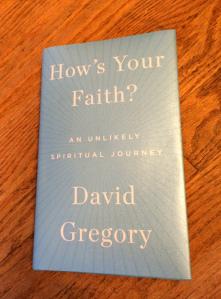
David Gregory and I are both children of Jewish fathers and Christian mothers, both of us raised Jewish. We both married mainline Protestants. We both have children with one Jewish grandparent, yet we are both passing on Judaism to our children. And we both tell our interfaith family stories in recent books. I am grateful for each interfaith family story that gets published, and especially for each adult interfaith child who speaks up about the complexities of interfaith life.
David Gregory, of course, is the former host of NBC’s Meet the Press. The arc of his memoir How’s Your Faith: An Unlikely Spiritual Journey traces his rise to television prominence, and his humbling fall when Meet the Press ratings sink and he loses his job at NBC. To be fair, his search for greater spiritual meaning started years before his career crisis, and this book is a disarmingly frank and raw accounting of how he has wrestled–with his difficult childhood, his own anger management, his career ambitions, and with how to raise Jewish children with a wife who is a church-going Methodist.
And there we have the primary difference in our interfaith narratives. My husband and I chose to raise our interfaith children with an interfaith education, in a community of interfaith families. David Gregory’s wife Beth agreed to help raise their children with one religion, Judaism. Their choice works for many families, as evidenced by the fact that many synagogues now are made up of a majority of interfaith families. But as I write in Being Both, each choice an interfaith family makes—one religion, or the other, or both, or none, or a third pathway, or all religions—is going to have specific benefits, and specific drawbacks.
Gregory is candid about the drawbacks, in particular about the persistent emotional pain his wife has experienced as a result of her agreement to raise the children without any exposure to her church. She tells him, “I think I was naïve about this decision…over time, I think I’ve come to feel it more, not sharing my religion with our kids.” Gregory writes that he feels “burdened by the weight of what she has sacrificed.” And by the end of the book, when their children are tweens, husband and wife have agreed that she can begin to occasionally start taking the kids to church, in order to support their mother.
How’s Your Faith left me with two burning questions. The first is about Gregory’s own strong claim to a Jewish identity. I feel the same way. At the same time, Gregory writes of feeling “…more Jewish than Christian, even though I feel more Christian than most Jews…”, an apt description of what I describe as the interfaith component of my own identity. But I know, from a lifetime of experience, that I have had to defend my claim to Jewish identity as a “patrilineal” child of a Jewish father, to the Conservative and Orthodox communities who believe Judaism is passed down only through the mother. I find it puzzling that Gregory does not give any weight to this struggle, nor explore how the institutional conflict over “Who is a Jew?” impacts interfaith children.
For me, the other mystery is why Gregory and his wife apparently discounted, at least until very recently, the idea of allowing their children to learn about and participate in both religions. As it happens, they settled in the Washington DC metro area, where my community, the Interfaith Families Project of Greater Washington, led by a minister and a rabbi, offers interfaith education for interfaith children and adults in a setting that allows both parents to be equal participants, without ritual restrictions or separate blessings. While this pathway, like all pathways, has drawbacks, it has allowed my family to avoid many of the most poignant and tearful scenes described in Gregory’s book.
After speaking to a few clergy members, Gregory dismisses the idea of choosing both religions without much explanation. And while he quotes a couple of books on interfaith families published in the last millennium, he seems unaware of the New York Times Op-Ed and book filled with data and interviews on this subject, both published as he was working on his manuscript. It is interesting to note that Gregory’s Orthodox teacher is on record as both citing the importance of, and simultaneously objecting to, this work on interfaith family communities. But as Gregory tours the country with his book, I know he is encountering the 25% of interfaith Jewish families Pew Research found raising children with both religions.
I was moved by the honesty and depth of Gregory’s depiction of his interfaith family life. By the end of the book, it sounds like he has a sense of some of the many ways that being part of an interfaith family can be a wellspring of spirituality, rather than a constant trial. I would invite him to dare to visit an interfaith family community—in DC, New York, Chicago or Philadelphia—and explore the joy we experience as interfaith bridge-builders.
Susan Katz Miller’s book, Being Both: Embracing Two Religions in One Interfaith Family is available now in hardcover, paperback and eBook from Beacon Press.

